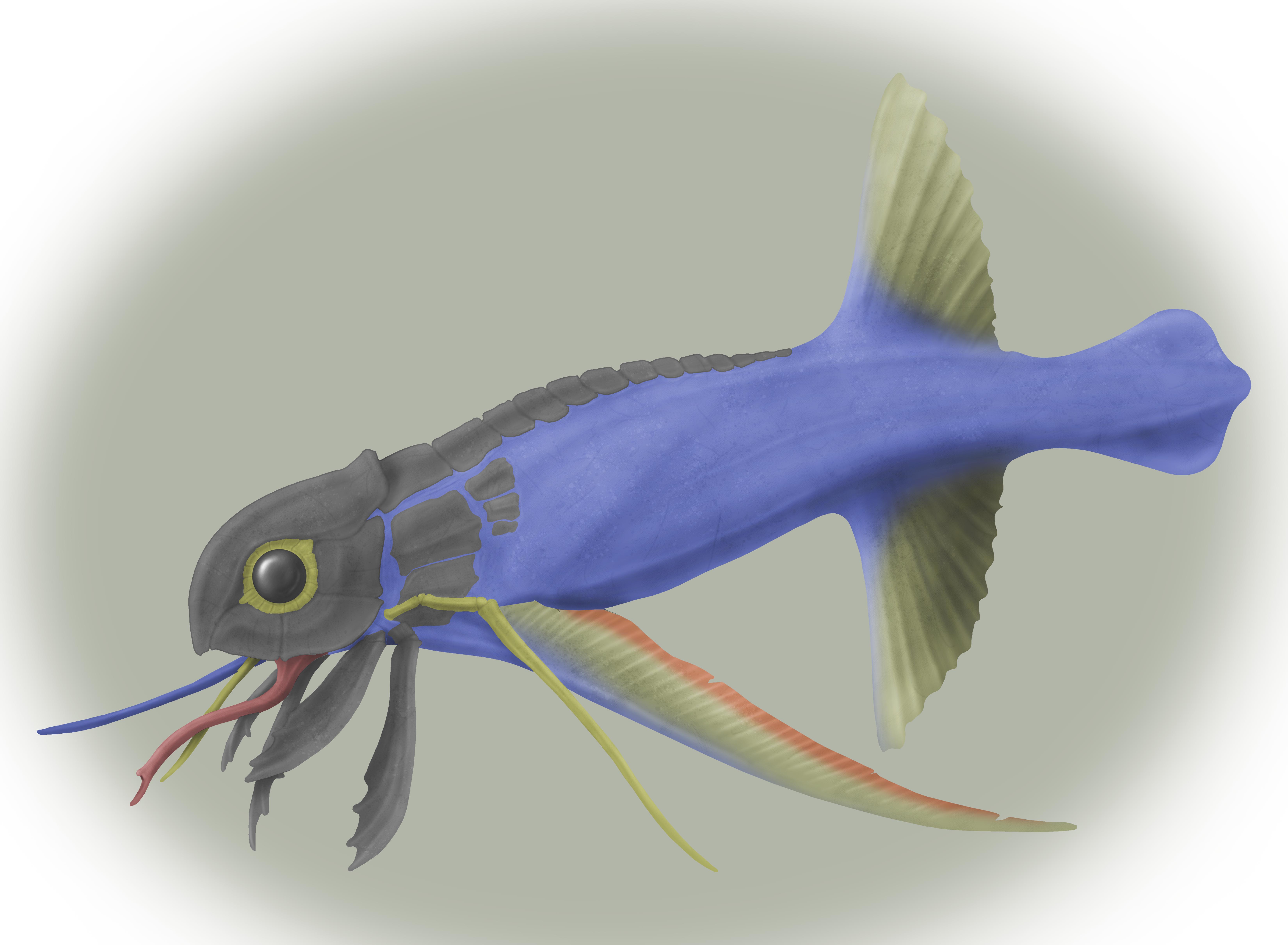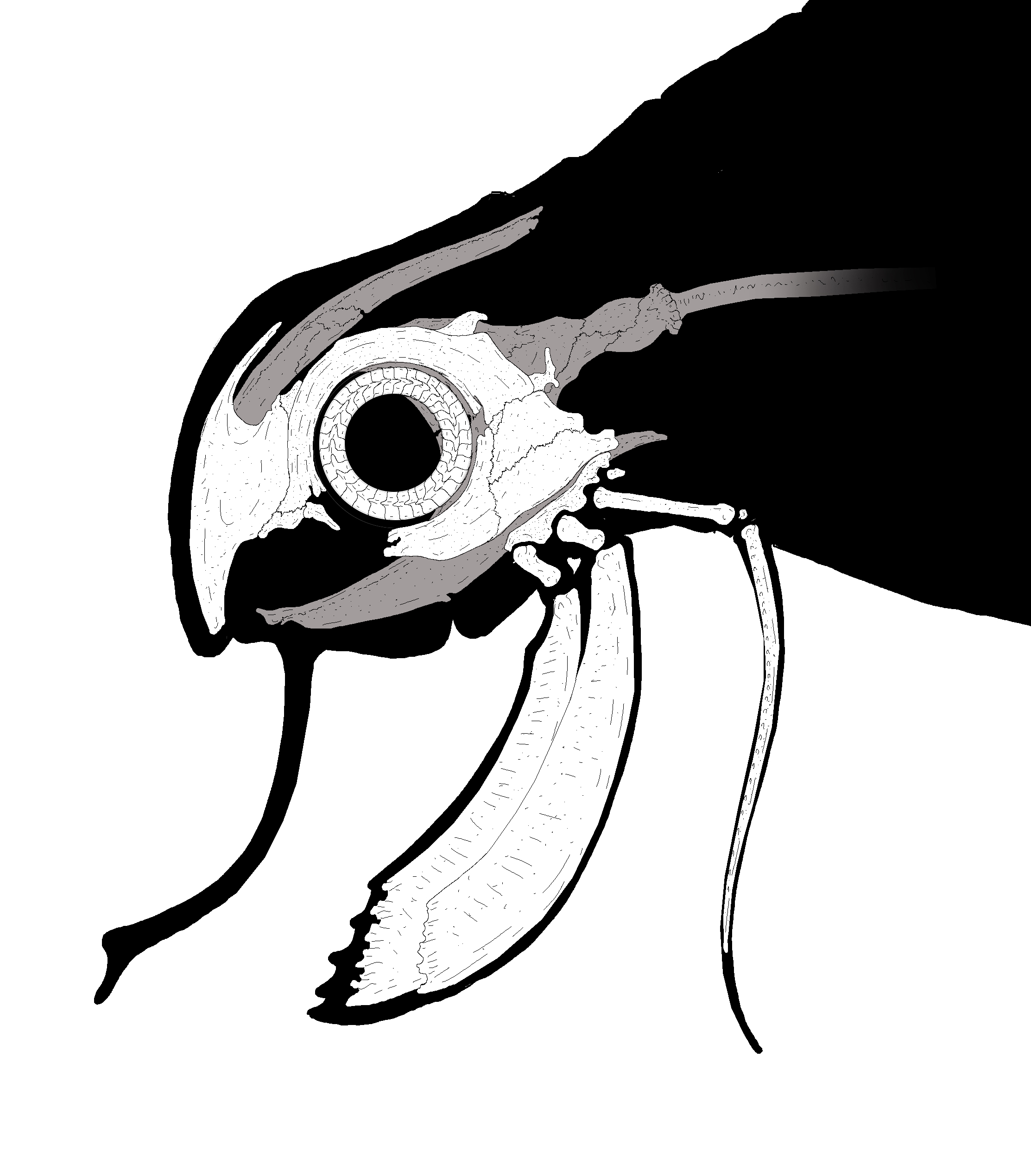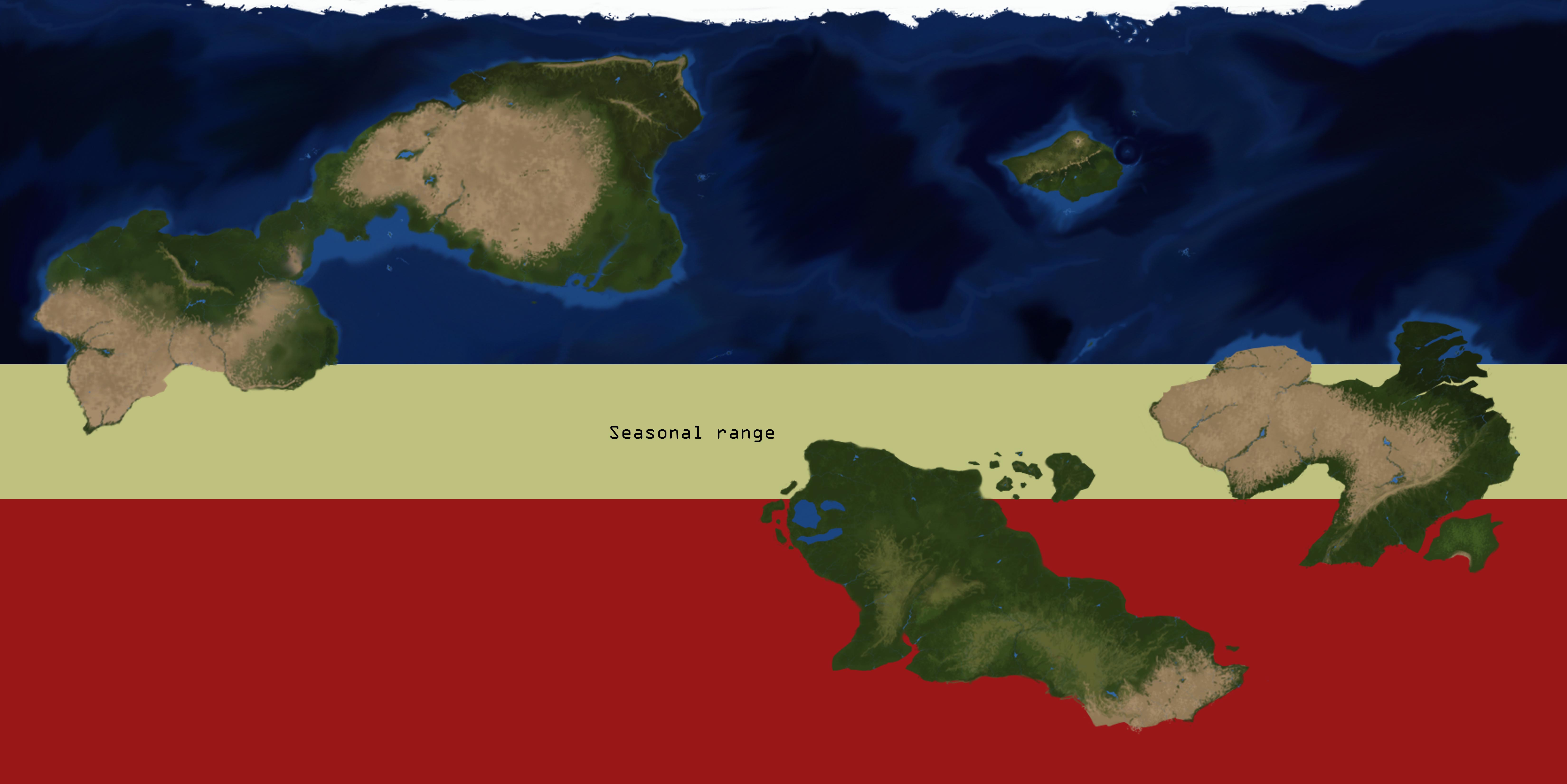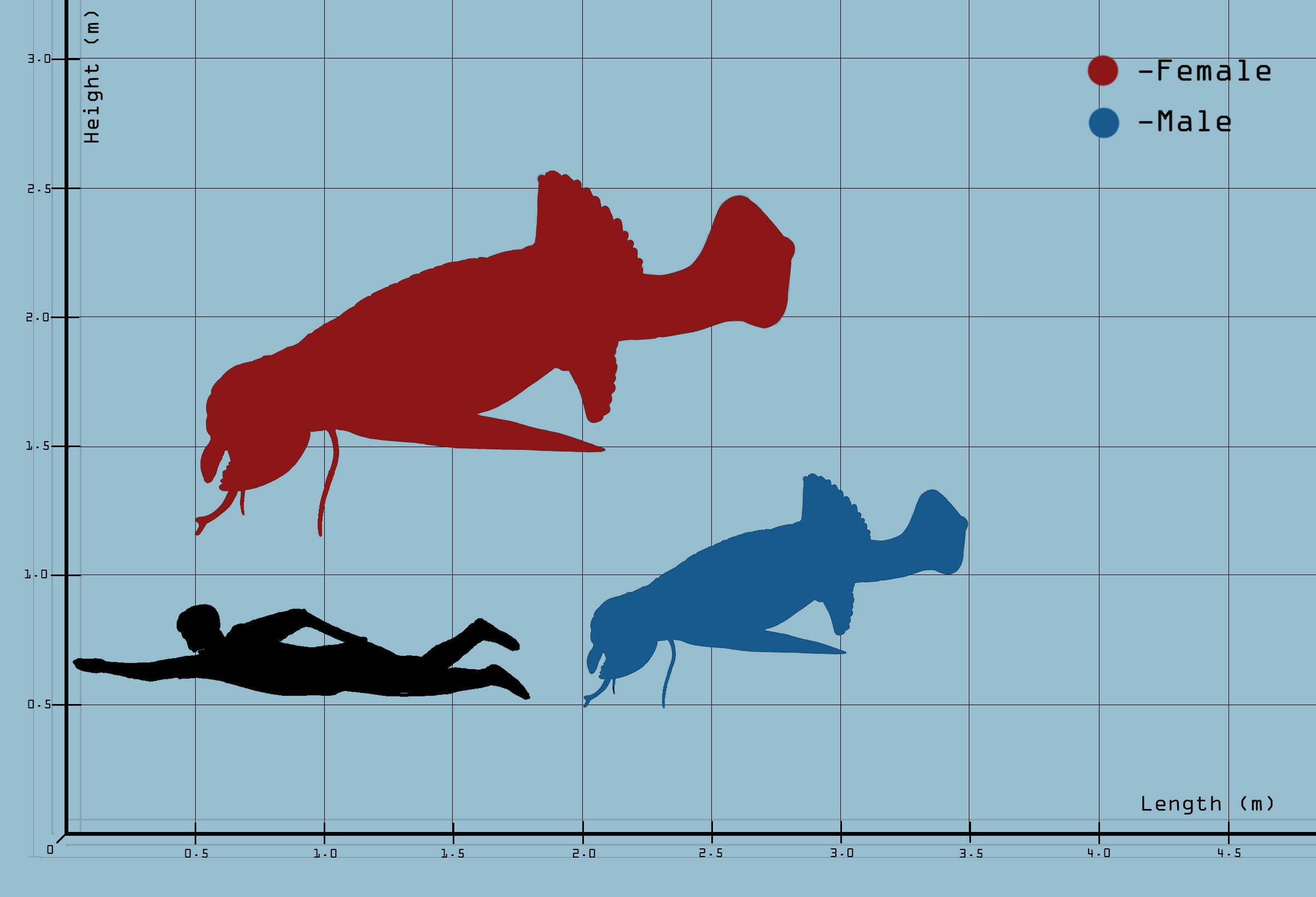Pelagic Doublejaw Kugawa
One of the biggest representatives of the Kugawas, this lonesome amphibian can be found hunting all across the Nuwadi Ocean.
In perhaps one of the most majestic feats of nature, every year this animal migrates north to the breeding grounds in the Tropical Belt in a gargantuan sized school comprising almost the animal's entire global mature population.
This event has been subject to various studies and research projects and continues to attract photographers, divers and fishermen every year.
While fishing the species during the migration is mostly prohibited, in some areas it is technically allowed to do so as they cross into international waters, meaning anglers from all over the planet will congregate in said spots in search of their trophy outside of the law's limits; several big fishing associations denounce this practice as to poaching and openly prosecute whoever is caught taking part in it.
Kugawa gigas became the symbol of the Union's militia during the 2410's and from there became the symbol of the nation after the Civil war; the animal is also commonly associated with strength and is a common figure in southern cultures' folklore with a notable presence in Neo Japanese's tales and graphical representations during festivals.
Although rare, attacks on humans have been registered, some of them fatal; this species alone has an average of 16 human deaths a year.
Basic Information
Anatomy
- Cranium very rounded.
- Cranial armour Segmented with very evident Sclerotic plates, armour absent in the ventral surface of the head; Armor extends throughout the length of the dorsum.
- Jaw I and II rounded and blunt, Tuberculus very long even in rest position.
- Jaw III very derived and Antennae like.
- Pectoral fins horizontally orientated and moved ventrally to the body.
- Dorsal and Anal II fins sail-shaped when extended and very flexible.
- Gill tail long and finishing in an overly developed Gill Fan with steep ridges and caudal drop.
Genetics and Reproduction
Seasonal monogamy.
The species reproduces in mid-summer; both genders will partake in a month-long migration to the nesting sites north of the Nuwadi Ocean, in the Tropical Belt.
The mate will be chosen by the female before migrating; the males will prepare beforehand fancy nests to attract females, these nests will often be decorated with bones, dead plant's exoskeletons and shiny trinkets they find laying on the seafloor.
In some of these nests, Divers found some Ancient's Exotechnologies the animals were using to attract females.
Once construction is complete, the males will shoot a chemical signal in the water that attracts the females.
Visiting females will browse the male's nest and move around the decorations, carefully inspecting what he harvested.
Shiny trinkets are especially effective as they are particularly visible by the animal's otherwise pretty poor eyesight.
If the female is convinced by the male's nesting skills, she'll signal him her receptiveness through chemical signals and slow clicks of the jaws; they then copulate.
The newly formed couple will immediately abandon the nest to migrate north.
Single specimens will migrate with the rest of the species but won't reproduce even if there are other single specimens of the opposite gender.
The females will incubate the eggs in the ducts during the migration and will immediately lay them as soon as they arrive at the mating grounds; competition for the best nesting sites can be fierce.
The males are in charge of finding a nesting site for the female and will fight fiercely other males contending the same spot, biting each other with crushing force.
Once the nesting spot has been conquered, the winner will click the jaws rhythmically, signalling the female his position, no two males have the same rhythmical call, making them distinguishable one to the other.
The best nesting sites are crevasses in the rocks, where the eggs can be better anchored.
The mature individuals will remain in the are for the time needed for the eggs to hatch, which varies between seven to thirty days, depending on the stage of development they were laid as.
Once the last of the offspring are born, the species will start the long journey back to the Nuwadi Ocean; the mature individuals are able to find their way back to their previous territories, researchers still today don't know exactly how they manage to navigate back to their previous position.
Growth Rate & Stages
Newly born Kugawa gigas are much rounder in shape with more curved Jaws and overdeveloped Dorsal and Anal II fins; during this stage of their life they are incredibly fast and agile, hunting smaller prey.
They will attach to their mother's Gill tail and get dragged by her for most of their young lives.
K. gigas will reach sexual maturity in the seventh year of age but will leave their mother only after three months from birth.
Loss of natal aculeus at the eleventh month of age.
Ecology and Habitats
Epipelagic animal found at depths between 0 and 200 m.
The live in clean pelagic environments where prey is most abundant, rarely found near floating forests.
Dietary Needs and Habits
Specialized predator feeding mostly on Selenopiscoidea amphibians such as Common Flapper; preys also on bigger prey and, although rarely, on humans.
Biological Cycle
Periannial amphibian with very few, minor, decreases in activity.
Additional Information
Social Structure
Lonesome animal living most of the year alone.
Becomes very social during the mating season, migrating together in a single school.
Communication between individuals very complex.
Observed interacting with its surrounding environment in a very complex way and using basic tools manipulating and grabbing them with the tuberculus; very curious.
Domestication
Kept in some public aquariums as a very popular exhibition specimen.
Very useful in ethological studies on the planet's fauna.
Uses, Products & Exploitation
Of local economic impact due to tourism with several maritime and island towns basing living off the yearly tourist flow due to the passing migration.
Although not legal, the animal is still targeted by fishermen given its status as a symbol of strength; poaching is still a severe problem to this day.
Geographic Origin and Distribution
Average Intelligence
Renowned for his intelligence, this animal has been observed communicating with conspecifics and interacting with the surrounding environment in a more complex way than most other animals on the planet.
Specimens studied in captivity have been observed reacting to light patterns and symbols as far as being able to communicate with humans through them, albeit in a very simple way.
Perception and Sensory Capabilities
Poor eyesight, extremely good chemical receptors.
Symbiotic and Parasitic organisms
Effected by Intestinal Tube Worms and Skin parasites.
in a mutualistic relationship with smaller amphibians who will keep it clean from said parasites.
Scientific Name
Enetodontia; Enetodontida; Paleostomatosoidea; Tubercolostomatosoidea; Kugawinidae ; Kugawininae; Kugawa; K. gigas
Lifespan
30 years
Conservation Status
Threatened: Several plans underway to protect the species, with special efforts from New Japan and the Union's governments.
Migratory routes reinforced by maritime police to avoid poaching.
Population trend: DECLINE
Average Weight
50 to 400 Kg
Body Tint, Colouring and Marking
Blue to deep Purple body color with Yellowish fins and Light to Dark Grey armor.
Bright Yellow Sclerotic plates and Jaw III.
Pale Orange stripe along the pectoral fin.
Remove these ads. Join the Worldbuilders Guild













Comments